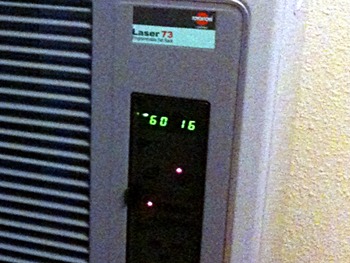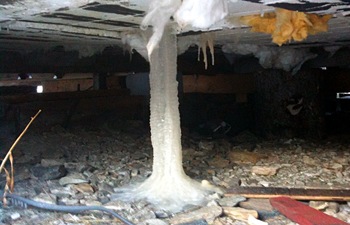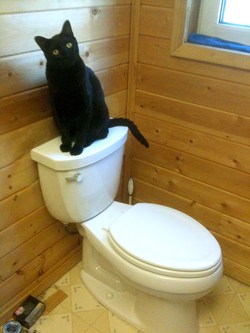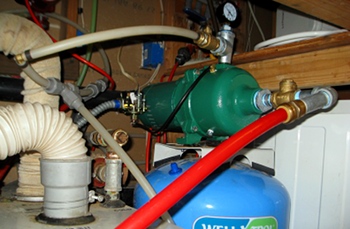A month ago, we noticed that our pump was coming on when we weren’t using any water. We immediately suspected the toilet because there was no evidence of water anywhere (on the floor, leaking under the house, etc.), but when we shut off the water supply to the toilet before going to bed, the tank was still full of water in the morning. The gaskets in our kitchen faucet were starting to fail, and it was occasionally leaking down the stem of the faucet, so we replaced the cartridge hoping this would solve our water problem. The faucet works a lot better, but we were still losing water.
We tried turning off the pump at night to confirm we really were losing water, and when we got up in the morning, we had no pressure. The combination of turning off the pump and the toilet supply resulted in no loss in pressure, so the leak was somewhere in the toilet after all. It wasn’t the flapper valve (or the tank would be empty in the morning), and we didn’t see any drips or leaks, so the supply must have been leaking into the top tank somewhere under the water and draining into the bowl where we didn’t notice it.
The obvious fix for this is to replace the stuff in the tank. But the toilet didn’t really work very well anyway, and used the full 1.6 gallons per flush. Andrea installed a dual flush kit that was supposed to use less water for liquid waste, but it didn’t work: the lower “number one” button didn’t release enough water into the bowl for it to actually flush. 1.6 gallons of water doesn’t sound like much, but we’re currently paying 10 cents a gallon for water, so we’re spending more than a dollar a day just to flush the toilet. We have an outhouse, but because we’re so close to Goldstream Creek, it can’t be in the ground and needs to be pumped out whenever it gets full. So our best option was to replace the leaking toilet with something that won’t leak, and uses less than the standard 1.6 gallons of water per flush.
The two current strategies to lowering water consumption in a toilet are to make the top tank smaller so less water is used for every flush, or to implement a dual flush setup where a small amount of water is used for liquids and the full volume flushes solids. Consumer Reports doesn’t give the dual flush models very high ratings, mostly because the bowl isn’t rinsed as well when so little water is used. As a result, we decided to get a toilet that uses a smaller top tank (1.28 gallons per flush). The highest rated model by Consumer Reports is an American Standard one-piece “Cadet 3,” but the local plumbing place and the box stores didn’t have that model in stock. Getting one shipped to Alaska would have taken more than two months. The next place models were the two-piece version of the Cadet 3 and the Kohler Cimarron. Consumer Reports gave the Cimarron slightly higher marks overall, with better bowl cleaning but worse solid waste elimination ratings. While we were in the store, we went to the web site for the company that rates toilets for solid waste elimination (www.map-testing.com) and consulted the latest ratings (from April 4th (!)). The Cimarron was better rated for this statistic (1,000 vs. 800), so that’s what we got.
Installation went smoothly. Thus far, we’re satisfied. What is surprising about the toilet is how fast it flushes. It empties the top tank into the bowl in less than a second, and the bowl empties almost immediately after that. It seems that the strategy is to dump almost all of the top tank water into the bowl as quickly as possible to eliminate waste, and use the small amount remaining to wash down the bowl. So far so good! We’re saving more than three cents each time we flush, and hopefully we will have many fewer double (and more…) flush events.

Cold cabin
Ever since I finished renovating the new cabin, we’ve been keeping it warm in the hope that we’ll find a renter for it. But once we passed the start of the semester at UAF, we essentially gave up looking and have been waiting out the winter to try renting it again. The place is heated by a oil-burning Toyotomi direct vent heater that was only a few months old when we bought the place because the previous heater had been stolen. In our house and the red cabin, we use a similar heater called a Monitor. In Fairbanks, “monitor” is the word people use to describe this style of direct vent heater. Unfortunately, MPI was purchased by Toyotomi and the line has been discontinued.
I’ve been trying to check on the new cabin every day, but I didn’t go over there on Thursday and when Nika and I went over there yesterday, the Toyo had quit working (WTF!?). I’d previously checked it around 4 PM on Wednesday, and finally got the heat back on at around 5 PM on Friday. It was 16°F in the cabin at that point. Over the course of those two days and one hour, the average outside temperature was -3.9°F. The cabin was 60°F when I left it on Wednesday, so it lost just under one degree per hour (although the heat loss is a function of the difference between internal and external temperature, so the heat loss isn’t linear). At that rate, it probably would have been above freezing if I’d checked on it on Thursday.
So mistake number one was not checking it every day. The heater had been so reliable thus far this winter that I got complacent.

Crawlspace icicle
Guess what mistake number two was? Thankfully I’d shut off the pump before closing the place up in fall, but there’s still at least 100 gallons of water in the tank in the bathroom, and water sitting in the pipes, pump and on-demand water heater. I went over there this morning to see if any of the pipes were cracked and if there was any water anywhere.
Initially there was no sign of damage except for a little water underneath the pump. After looking under the house (see the photo on the right), it’s clear that there’s a leak somewhere near the pump, and all the pressure left in the pressure tank pumped a few gallons of water onto the floor, where it found a way to get through the vinyl floor, the new subfloor I installed this summer, and down into the structure and eventually out the bottom of the cabin.
After fiddling with opening faucets, I eventually hit on some combination of open valves that released a vacuum near the hot water heater, and water started pouring out, so there’s a leak somewhere in the hot water heater as well as near or inside the pump. Later in the day I went back with an air compressor and forced air into the hot and cold water lines, opening and closing different faucets until I forced all the water out of the pipes.
Lessons learned: check on the heat every day, and if there won’t be anyone in there, make sure to blow out all the water lines. In spring I’ll be replacing the hot water heater and probably the pump. Hopefully the pressure tank and the washing machine weren’t damaged, but at least I don’t need to replace the water lines or the water tank.
Spent much of the day today getting parts and replacing our water pump. The old one wasn’t drawing water out of the tank very well, didn’t show pressure on the gauge, and couldn’t be primed without taking it off of the pressure tank. Earlier in the week we had a brief freeze-up of our supply line and I decided it was the last time I was going to drag the old pump off the pressure tank just so I could prime it.
The new pump is a Myers pump, Made in the U.S.A., and seems to be a little quieter than the old one. While I was doing it, I replaced a few more of the plastic compression fittings in the mechanical room with crimp-style fittings. The plastic ones are no longer sold because they eventually leak.
One remaining issue is getting the pressure tank and the pressure switch working well together. When I first hooked it up, I lowered the pressure tank to 18 psi (2 pounds lower than the low setting the switch is supposed to default to), and the pump starting rapidly switching itself on and off again. I tried lowering the pressure in the pressure tank until there was nothing left in it, and then started looking at the new gauge. Turns out the new switch was set to something like 15–30 instead of 20–40. After I filled the pressure tank back to 18 psi and adjusted the pressure switch to 24–35, everything works without the on-off-on-off problems. I’d like it to be closer to 20–40, but that will take some fine tuning of the pressure switch.
When we first moved into our new house I was pleased that the system for keeping the water and waste water lines running in winter was based on circulating warmed glycol, rather than electrical heat tape. Heat tape is known to fail without warning, and sometimes even shorts out and starts a fire.
Unfortunately, the setup is quite peculiar. We’ve got a small heating-oil-fired boiler (the white box on the left of the photo) that heats an internal five gallon water tank. A circulating pump from this tank runs into a plate heat exchanger with the hot water on one side and circulating glycol on the other. A second circulating pump circulates glycol out to the water tank, and back around to the discharge pipe running to the sewage treatment plant. With the boiler set around 165°F, the glycol stays between 80–100°F, depending on the temperature outside. The guy who built the place also ran lines to all the bedrooms and the living room so that hot water or glycol could be used to heat the house, rather than using the small, self-contained Monitor heater we’re using now.
There are a couple problems with this system. In order for the boiler to keep the glycol warm enough via the exchanger, the water temperature has to be quite a bit warmer than is usual for a domestic hot water supply. That’s dangerous for someone not familiar with how hot the water will be when it comes out of the tap, and it’s not all that efficient to keep the hot water at such a high temperature. It also seems like this high temperature is necessary to provide for enough hot water that a normal-length shower will stay warm throughout. And there’s no way the boiler would be up to the task of heating radiators throughout the house, in addition to what it’s doing now.
But the more immediate problem is that the glycol lines were accidentally cut and then improperly repaired before we moved in. We were told that the repair was successful, but when the temperature got cold this winter, glycol started leaking out of the repair. Since the glycol lines are plastic, there’s no way to fix the leak during winter. And even when the lines aren’t leaking at low temperatures, air is slowly drawn into the lines through the same faulty repair. After a couple months, the amount of air in the circulating lines is large enough that the lines become really noisy.
The way to get all the air out of the lines is to recharge the glycol, a procedure I performed for the third time this weekend. This involves connecting a transfer pump to the two sides of the circulating loop with a bucket of glycol in the middle. The procedure is to hook up the transfer pump, turn off the circulating pump, turn on the transfer pump, open the system and allow the transfer pump to circulate glycol for fifteen or twenty minutes until the air has been removed. Then close the return side of the glycol lines and allow a bit of pressure to develop before closing the supply side and turning off the transfer pump. Since the system doesn’t need any pressure at all to operate, the last step before turning on the circulating pump is to carefully open one side of the glycol system and allow most of the pressure in the system to force out the remaining glycol. It’s possible that leaving pressure in the lines might force a bit of glycol out of the leak, rather than allowing air into the system, but I’d rather recharge the lines every couple months than deal with a glycol spill.
This weekend is the Home Show, where a bunch of vendors get together in the Carlson Center and show off their products. I’m hoping we can get some suggestions and ideas from people about a better setup for the house. I have a feeling that a larger boiler, combined with a small hot water storage tank might be a better system. The boiler would be heating water or glycol for the outdoor lines, water for radiators in the house, as well as keeping the hot water storage tank warm for our hot water supply. The space we have available (in the photo) isn’t very large, so we may need to build a small bump out on the back of the house to accommodate the new equipment. Anyway, I’m hoping we can come up with something and maybe even get it installed this summer so we can go through next winter without worrying about what will happen when our small boiler fails (which it did at one point this winter).


